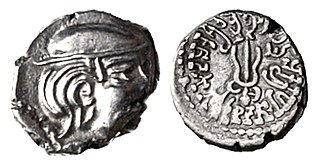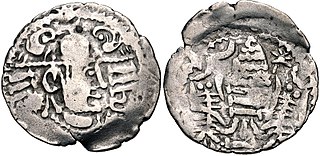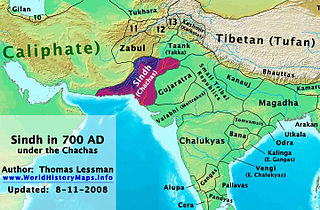
The Maitraka dynasty ruled western India from approximately 475 to approximately 776 CE from their capital at Vallabhi. With the sole exception of Dharapaṭṭa, who followed the Mithraic mysteries, they were followers of Shaivism. Their origin is uncertain but they were probably Chandravanshi Kshatriyas.
The Vaghela dynasty were an offshoot vassal clan connected to the Chaulukya (Solanki) dynasty, ruling Gujarat in the 13th century CE. Their capital was Dholka. They were the last Hindu dynasty to rule Gujarat before the Muslim conquest of the region.
Vallabhi is an ancient city located in the Saurashtra peninsula of Gujarat, near Bhavnagar in western India. It is also known as Vallabhipura and was the capital of the Suryavanshi Maitraka Dynasty.
Nagabhata II was an Indian Emperor from Gurjara-Pratihara dynasty. He ascended the throne of Gurjara-Pratihara dynasty after his father Vatsraja. His mother was queen Sundari-Devi. He was designated with imperial titles - Paramabhattaraka, Maharajadhiraja, and Paramesvara after conquest of Kannauj.

The Chavda (IAST:Chávaḍá), also spelled Chawda or Chavada was a dynasty which ruled the region of modern-day Gujarat in India, from c. 690 to 942. Variants of the name for the dynasty include Chapotkatas, Chahuda and Chávoṭakas.

In the first half of the 8th century CE, a series of battles took place in the Indian subcontinent between the Umayyad Caliphate and kingdoms to the east of the Indus river.
The Gurjaras of Lata, also known as Gurjaras of Nandipuri or Bharuch Gurjaras, was a dynasty which ruled Lata region as a feudatory of different dynasties from c. 580 CE to c. 738 CE.

Ghumli is a village located 45 km from Porbandar, at foothills of Barda, in Devbhumi Dwarka district of Gujarat, India.
Valabhi University was an important center of Buddhist learning and championed the cause of Hinayana Buddhism between 600 CE and 1400 CE. Valabhi was the capital of the Maitraka empire during the period 480-775 CE. It was an important port for international trade located in Saurashtra, present-day it is called Valabhi located in Bhavnagar district of Gujarat in western India, identical with the old state of Vala. Yijing, a Chinese traveller had observed that education given at valabhi was comparable to the education provided at Nalanda, in Bihar, in the field of education. In September 2017, the Indian central government started to consider a proposal to revive the ancient university. A proposal, under the umbrella of an organisation called Sanghkaya, was sent to the central government, which the Union ministry of culture has agreed.
The Guhilas of Medapata colloquially known as Guhilas of Mewar were a Rajput dynasty that ruled the Kingdom of Mewar region in present-day Rajasthan state of India. The Guhila kings initially ruled as Gurjara-Pratihara feudatories between end of 8th and 9th centuries and later were independent in period of the early 10th century and allied themselves with the Rashtrakutas. Their capitals included Nagahrada (Nagda) and Aghata (Ahar). For this reason, they are also known as the Nagda-Ahar branch of the Guhilas.

The Sharabhapuriya dynasty ruled parts of present-day Chhattisgarh and Odisha in India, during 5th and 6th centuries. The dynasty probably served as Gupta vassals in their early days, but became practically independent as the Gupta empire declined. The Sharabhapuriyas were succeeded by the Panduvamshis. The dynasty is known mainly from its copper-plate inscriptions, and a few coins.
Tribhuvanapala was the last king of the Chaulukya dynasty of western India. He ruled parts of present-day Gujarat from his capital at Anahilapataka. He ruled for a short period before dying heirless or being dethroned, after which the Vaghelas assumed control of the kingdom.
Ra Mokalasimha, also known as Muktasimha, was a Chudasama king of Saurashtra region of western India who reigned from 1384 CE to 1396 CE. He ruled from Junagadh and later moved his capital to Vanthali when Saurashtra came under influence of the Delhi Sultanate.
Mahipala I was a Chudasama king of Saurashtra region of western India who reigned from 1308 CE to 1331 CE. His capital was at Junagadh.
Mandalika I was a Chudasama king of Saurashtra region of western India who reigned from 1294 CE to 1306 CE. His capital was at Junagadh.
Khengara was a Chudasama king of Saurashtra region of western India who reigned in the 12th century. His capital was at Junagadh. He was a contemporary of Jayasimha Siddharaja, the Chaulukya ruler of Anahilapataka. According to bardic tales, he was a son of Navaghana and had succeeded him.
Navaghana was a Abhira chief of Saurashtra(This Ruler is Grandson of Ra' Navghan who was saved by Devayat Bodar) region of western India who reigned in the late 11th century. His capital was at Junagadh. He was a contemporary of Jayasimha Siddharaja, the Chaulukya ruler of Anahilapataka. According to bardic legends, Jayasimha attacked during his reign and he was defeated and became is vassal. He moved capital to Junagadh. He was succeeded by Khengara who had vowed to take revenge.
Chudachandra, also known as Chadrachuda or simply Chuda, was a legendary king and founder of the Chudasama dynasty of Saurashtra.
Hariprasad Gangashankar Shastri was an Indian scholar, historian, epigraphist, Indologist and editor primarily known for his work on the political and cultural history of Gujarat state. He spent much of his career at the B. J. Institute of Learning and Research, Ahmedabad, as a lecturer, professor, deputy director and then as director.
Shiladitya of "Mo-la-po" was a 6th-century king of India, known only from the writings of the 7th-century Chinese traveler Xuanzang. Several modern scholars identify this king as the Maitraka king Shiladitya I alias Dharmaditya, although alternative theories exist.







